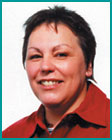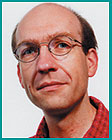In September, 2006, two new research units will join the theoretical research groups at RIKEN Brain Science Institute. In addition to conducting experiments, the presence of the units promises to be a new social experiment for RIKEN-a change that could influence science management and open doors for researching couples. These units might also catalyse more interaction between experimental and theoretical laboratories within RIKEN BSI with exciting results. These new units, you see, are, like their unit leaders, a couple: partners in research.
Husband and wife team, Markus Diesmann and Sonja Gruen, are German scientists with a passion for theoretical brain science. The pair was working in separate institutes in different parts of Germany.
According to Markus, they want to "understand thinking, to find out how we solve problems." Moreover, they wanted to do it together. RIKEN BSI offered them a way to do that.
Although Sonja was encouraged to apply by an American colleague, it was the campus that convinced her to come to RIKEN.
"When I stepped onto the campus, I thought, 'this is just like the Weizman Institute of Science in Israel: a closed campus, well-organized with tree-lined paths.' And with such a large conglomeration of scientists-you just feel the spirit of science. And I knew that this was it." Her emotional description of the campus, however, fades next to the questions these two scientists have about the brain.
As a computational neuroscientist, the clumsy nature of the brain puzzles Markus. "When compared to the processing speeds of computers, the individual elements of the brain-the nerve cells, also called neurons by the scientists-are so slow and sloppy." Of course, at the system level, the brain is capable of wonders no man-made machine can yet match. How can such complexity emerge from the lower level chaos? He hopes to help answer that question by developing a model of one cubic millimetre of human cortex.
To do this he presently uses twenty-four computers, each housing four computing cores in two processors. These machines occupy the same space as a good sized walk-in closet-one meter wide by one meter long by two metres high. Yet, processing power is not the only problem. The real interior design challenge is housing the few kilometres of "biological" cabling connecting the nerve cells. Imagine having trouble fitting your clothes into that closet because the hangers take too much space-the supporting elements are more demanding than the real processing units are. And Markus thinks neurons are sloppy-look what he needs just to attempt to model one cubic millimetre of cortex.
But let's put that into perspective. Within one cubic millimetre of cortex, there are six cortical layers, 105 neurons with104 neural connections each. This is the minimal network size at which any pair of neurons has a realistically low probability of being connected (about 0.1), yet each neuron can establish a realistic number of contacts. That level of interactive brain complexity boggles the mind. In that light, one might marvel at the dexterity of human ingenuity that can house 109 possible interactions within a dynamical changing structure in the space the size of a closet.
"We know that the brain is constantly changing and that neuronal responses are not fixed," the no-longer soft-spoken Markus explained. "How can you model neuronal activity in such a dynamic and rapid state of change?" This is the challenge, and one that seems to go counter to the current neural network trends at BSI.
The robotics researchers at BSI are attempting to simplify the neural networks they use-arguing that complexity emerges from that simplicity. Markus would not disagree, but he points out that hardware is more costly and inflexible. It is far more efficient and cost-effective to develop and manipulate abstract models using the software on immobile computers than to make radical changes on those models involving mobile hardware (robots). But Markus does collaborate with those researchers, after all, brain-like devices will ultimately need to be mobile.
Does Sonja get to play with the mini-super computer, too? Indirectly, yes, but for her it is a more of a tool. "My role," explained Sonja, "is to analyse the biological data by collaborating with experimental scientists in an effort to understand how the brain works and use my findings to guide modelling in more realistic ways." After all, she continued, it is not one neuron, but a network with emergent properties that organizes the communication between neurons and groups of neurons. These emergent functional groups, as well as the changes in grouping that occur with the computational demands and network use, are what she wants to understand.
To answer their questions, they will need to work with various labs at BSI. There are many opportunities to work with experimental researchers at BSI, but Sonja has set her sights on collaborations with Manabu Tanifuji's lab (Integrative Neural Systems) which is producing interesting results on brain activity using simultaneous recordings. Dr. Amari and another new lab headed by Hiro Nakahara are also working in theoretical areas close to hers. She needs new statistical tools for her analysis, and these two labs may be able to help. Sonja also said that she is eager to set up discussion groups to help create common ground between the various research areas.
"Sonja is also attempting to build simple statistical models based on experimental data that can then be verified by the network models I am building," Markus added. "Conversely," he continues, "the analysis tools developed for the experimental data, can be used to interpret the simulation results. " That is a nice partnership, learning and developing together.
"I find that I am often in the role of calibrating the theoreticians," Sonja added, by showing them the data and saying that they cannot make certain assumptions.
Yes, Sonja's job is to tell researchers what cannot be done. But, researchers more than most, dislike being told no. When I asked her, a woman full of curiosity and passion, about her diplomatic skills, she fell silent. Markus laughed.
"I am working on it," she chuckles, and a few seconds later, she was laughing too.
"I am definitely the diplomat in the couple," says Markus, "and it is a role I enjoy. I see this as one of my responsibilities-to bring people together to let them do great things."







